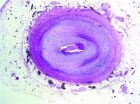The findings suggest that it could be possible to use cough suppressant syrup as a probe, which would enable doctors to identify patients with altered metabolism and use this information to improve individual treatment, making it more effective and reducing the chances of side-effects.
Tamoxifen, which is widely used both to treat and prevent breast cancer, is metabolised by the body into endoxifen, which is responsible for the drug's anti-cancer activity and which can cause tamoxifen-related side-effects. Two enzymes, CYP2D6 and CYP3A, are responsible for metabolising tamoxifen into endoxifen, and the metabolite forms only if there are sufficient quantities of these enzymes.
Mrs Anne-Joy de Graan, a PhD student in the medical oncology department at the Erasmus Medical Centre in Rotterdam (The Netherlands), who presented the study, explained: "At present, all patients treated with tamoxifen in The Netherlands are prescribed a fixed dose of 20 mg or 40 mg. But there is a large difference in the toxicity (for example, hot flushes, endometrial cancer and thrombosis) and efficacy of this agent. This is thought to be the result of variance in endoxifen concentrations between patients. Recently, research has focused on whether this variation in endoxifen levels is caused by patients' individual genetic make-up. We know that there are genetic variations that cause women to be 'poor metabolisers'. This means that these women cannot form enough endoxifen due to absence of CYP2D6 enzymatic activity." In addition, other factors can influence a way a woman metabolises tamoxifen, such as CYP3A enzymatic activity, the use of other medicines, alcohol consumption and smoking.
Mrs de Graan and her colleagues at Erasmus studied the use of dextromethorphan, the active ingredient in cough suppressant medicine, in 40 breast cancer patients who had been taking tamoxifen for more than three weeks. Dextromethorphan is metabolised in the same way as tamoxifen and is harmless to the patient. "It is a so-called 'probe' drug, a harmless substance that can be used to predict the metabolism of another drug. We used dextromethorphan to evaluate its use as a probe drug for tamoxifen metabolism," she said.
The researchers gave their patients 30mg of dextromethorphan as liquid cough syrup and then asked them to take their oral tamoxifen two hours later. Over the next 24 hours they took different blood samples to measure both dextromethorphan and tamoxifen metabolites, and then calculated how well dextromethorphan metabolism predicted and correlated with tamoxifen metabolism.
"We found that dextromethorphan is a very good way to predict endoxifen concentrations," said Mrs de Graan. One patient was taking the anti-depressant, paroxetine, which is known to inhibit CYP2D6, and the dextromethorphan probe accurately predicted the resulting lower concentrations of endoxifen.
Measuring dextromethorphan is easier than measuring levels of the metabolite endoxifen and, in addition, it can be applied to other compounds that are metabolised by CYP2D6 and CYP3A.
"Tamoxifen is prescribed to women for as much as five years in the adjuvant setting, so it is highly important to know beforehand if the therapy is going to be effective. When it is known that a woman metabolises tamoxifen poorly, a switch in drugs or an increase in dose can be considered. Looking at a patient's genetic make-up (genotyping) is one possible way to predict the metabolism of an individual patient, but it only looks at one gene for one enzyme involved in the metabolism of tamoxifen: CYP2D6. However, tamoxifen is also metabolised by another enzyme: CYP3A. Furthermore, a patient's metabolism is not only influenced by genes, but also by other factors such as co-medication and environmental factors. The dextromethorphan phenotyping test takes all these factors into account in predicting tamoxifen metabolism," said Mrs de Graan.
The test needs to be refined and improved so that fewer blood samples are required and it is easier to use; it also needs to be tested in another group of patients. If this proves to be successful, then the researchers will have to develop a dosing strategy and test it in a phase III trial in order to compare it with current practice.
"Research today focuses more on the treatment of the individual patient. We now know that every patient responds differently to therapy. It is largely unknown why one patient experiences more or fewer side effects or why some patients respond better or worse to therapy. Therefore, it is highly important to identify prognostic factors that predict this response. We believe that tailored therapy will optimise treatment with systemic therapy. The current dosing strategy does not take individual differences into account like co-medication, DNA difference, life-style factors like smoking behaviour, and alcohol consumption. Genotyping tamoxifen-treated patients is just one step towards individual treatment, but different results are reported in the literature. We investigated another way of predicting tamoxifen metabolism by phenotyping, which takes various individual differences into account. Future research will tell which strategy for individualising treatment will be the best to implement in daily practice. Our dextromethorphan test could aid in future studies on the association of tamoxifen and CYP2D6 genotype and phenotype, and ultimately in the personalisation of tamoxifen treatment," concluded Mrs de Graan.
### Abstract no: 654. Poster on Friday 19 November in the Exhibition Hall (ground level) from 07.00/08.00 hrs to 13.00 hrs CET.
Notes:
[1] EORTC [European Organisation for Research and Treatment of Cancer, NCI [National Cancer Institute], AACR [American Association for Cancer Research].
[2] Genotype and phenotype: genotype is the internally coded, inheritable information carried by all living organisms in their DNA; phenotype is the outward physical manifestation of this, which takes account of all physical parts, functions and behaviours, their interplay and the effect on them caused by their environment.

